A few months ago when I solicited suggestions for future Historical Sew Fortnightly challenges someone asked if we could do an ‘Up-Cycle’ challenge and I said “Absolutely not.”
Not because it’s a bad idea, but because I loathe that word. The word was a good idea to begin with, but has been used to describe so many silly, dreadful things that it has lost its credibility.
While I don’t like ‘up-cycle’ as a trendy word, I distinctly applaud the idea of taking old things and giving them new life, and new purpose. It’s a very historical idea – fabric and materials were very expensive, and people got as much use out of them as possible.
In this spirit, the Historical Sew Fortnightly Challenge #18 is Re-make, Re-use & Re-fashion. Sew something that pays homage to the historical idea of re-using, re-making and re-fashioning. Turn one thing into another. Re-fit or re-fashion an old gown into something you would wear again. Re-trim a hat for a new outfit, or re-shape a modern hat to be a historical hat. Re-purpose the fabric from an old garment (your own or a commercial one) into a new garment.
There are numerous examples of gowns made from 18th century fabric that were re-made a number of times in the 18th century, and then re-made again in the mid-19th century, a hundred years after the fabric was first woven.
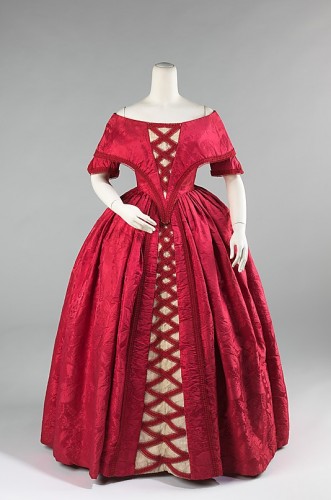
Ball gown, ca. 1842 (fabric 1740s), British, silk, cotton, Metropolitan Museum of Art
Throughout the 18th, 19th and early 20th century hats were de-constructed and re-trimmed, the embellishments used on other hats, and the hat frame used for new embellishments.
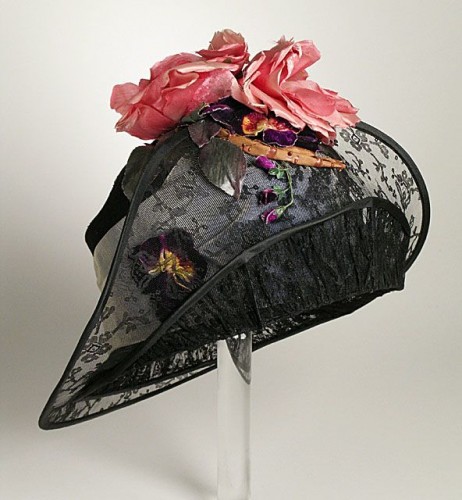
Cloche, Jardine hats, 1917, LACMA
Gowns were made over to accommodate new styles by removing and replacing the trimmings, or changing the silhouette. They were also made-over to accommodate changing body shapes as the wearer’s body changed.
Lace was a particularly common component of re-fashioning. It was treated more as an accessory than a fabric, and would be moved from one garment to the next. Even Queen Victoria removed the lace from her wedding dress and re-used the lace, and had the dress re-styled with different lace.
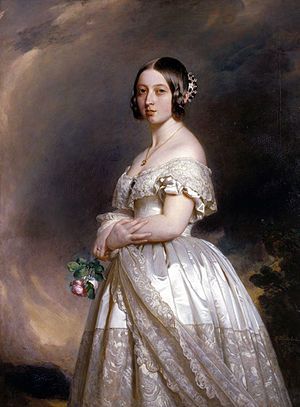
Queen Victoria poses in her wedding dress
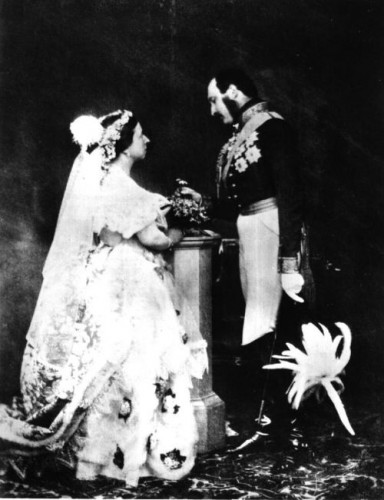
A middle aged Victoria and Albert, the Queen in her re-styled dress
I’ve already done a number of re-makes this year. I re-fashioned a modern fedora into a cloche for Embellish and again for Accessorize, and a modern straw hat into a bergere (both with tutorials!) for Stripes. The pet-en-l’aire that I finished for Embellish was made from a vintage obi (though that’s really sort of re-make lite, as an obi is just a rectangle, though I did have to take it apart and piece a great deal). I re-made an old fur sleeve into a muff for Flora & Fauna, and also re-fashioned a pair of modern kitten heels into late 18th century shoes for the same challenge.
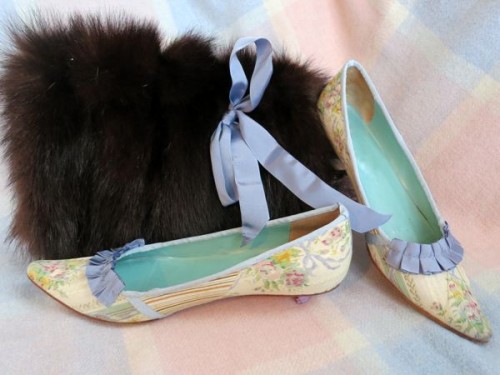
I’ve got so many more re-makes that I want to do though…multiple pairs of shoes to make over, more hats to re-fashion, a bit of a re-make of my Greek-Key ensemble (and another Greek Key ensemble that you have never seen to re-make slightly), and some modern garment that have beautiful embroidery or beading that I want to cut apart and re-make as a historical piece. I’ll have to decide what to make when I get closer to the challenge!

I hate the term “up-cycle” too. It feels like a euphemism for something that doesn’t need a euphemism. And where does the “up” come from?
Re-make, re-use, and re- fashion is a great idea.
A lot of my early sewing projects are horrible and need to be remade or cannibalized.
I like the idea of lace being a migratory creature. I have a lot of old handmade lace, but haven’t used any of it because I have no idea how old it is. Using 100 year old textiles is something I would be very reluctant to do.
I think the ‘up’ is meant to make it sound cooler. Like if you recycle, you’re just turning one thing into another thing of equal or lesser value. If you ‘up’-cycle, you’re turning something old and ugly into something trendy and happening. I’m sure its the brainchild of some marketing guru who thought ‘re-making’ or ‘re-using’ is just not ‘edgy’ enough.
I had a friend who used the word “hand-me-ups” to describe clothes that his younger brother would pass along. I thought it was cute because it was a clever joke. And I even liked “upcycle” too–the first time I heard it. I thought it was a joke. Don’t know how I feel about it entering the lexicon.
Oh-ho!
Almost all of my costumes are deserving of being re-fashioned. Being completely self-taught, I made many “practice” pieces.
Now I’ve learned a lot more about sewing techniques and taking time to make it look nice, and I cringe when I look at the things hanging in my closet.
royalcollection.org.ukroyalcollection.org.ukI’m not so sure that Victoria IS wearing her wedding dress in that photograph. The Royal Collection certainly don’t identify it as the wedding dress, just as “a wedding dress?” (and have since added another para to the description, which says it is court dress, and that V&A have just attended a Drawing Room.)
http://www.royalcollection.org.uk/collection/2906513/queen-victoria-and-prince-albert-buckingham-palace
Plus, it’s the same dress as this one (which is on Wikipedia named “Queen Victoria wedding dress”!!) http://www.royalcollection.org.uk/collection/2906515/queen-victoria-1819-1901-buckingham-palace
I’ve compared it very closely to photos of the actual wedding dress, and while she certainly got a lot of wear out of the lace, I can’t help thinking we’d see more signs of stitching/modifications/wear on the actual dress showing up on the plain white satin fabric, even with loads of conservation and careful mounting to try and hide the worst bits. One only has to look at the state of Alexandra’s dress after all the flouncy bits were removed, and I’m thinking we’d see more of that on QV’s dress if it were the case she had remodelled it. So perhaps it’s not actually a remodelled dress at all…
(Coincidentally I came across the photos from your earlier blog post back in 2011 – the wedding lace is not lost, it’s just now in such a fragile state it can’t even be removed from storage… and given how much wear V had out of it, quelle surprise…)
I’ve spent too much time on Regretsy to be comfortable with the term “up-cycle”. But I definitely have ideas for this challenge. You come up with some brilliant challenge themes.
Hehe. That’s exactly my problem! It’s used to describe so many things that are distinctly not an improvement!
Just stopping by to express my distaste for the word ‘upcycle’….
Yay for refashioning! (That is all…)
I have just posted my completed HSF #18 project on my blog. This is my first entry into the Challenge. What is the correct way to submit the entries? I’m going in circles with the links. Thanks!!
Just leave a comment right here with a link to your blog post 🙂
I’ve just posted about my entry for this challenge: a Regency tiara made from modern bracelets.
http://quinnmburgess.wordpress.com/2013/09/02/hsf-18-red-and-gold-regency-tiara/
Best,
Quinn
[…] cette semaine. Ensuite je voudrais faire de nouvelles modifications sur ma robe orange 1880 pour le challenge HSF de cette semaine. Après ça j’avoue que mes projets couture ne sont pas encore arrêtes, on […]
[WORDPRESS HASHCASH] The comment’s server IP (72.232.112.44) doesn’t match the comment’s URL host IP (66.155.9.238) and so is spam.
[…] Challenge: #18: Re-make, Re-use & Re-fashion — due September 9. Sew something that pays homage to the historical idea of re-using, re-making […]
[WORDPRESS HASHCASH] The comment’s server IP (66.155.9.34) doesn’t match the comment’s URL host IP (66.155.9.238) and so is spam.
http://isabelladangelo.blogspot.com/2013/09/historical-fortnightly-18-re-make-re.html
My very first “garb” turned into something slightly more accurate. (Yay! No more zipper!)
Finished another 18th century petticoat…this one is made out of an old mid-19th century petticoat. http://livingwithjane.blogspot.com/2013/09/historical-sew-fortnightly-challenge-18.html
[…] poil depuis la dernière fois où vous l’avez vu, en revanche j’ai voulu participer au challenge n°18 du HSF (pour lequel je suis très en retard). Le challenge consistait à refaire, reutiliser ou […]
[WORDPRESS HASHCASH] The comment’s server IP (66.155.9.42) doesn’t match the comment’s URL host IP (66.155.11.238) and so is spam.
It’s a little late, but I made a neckerchief out of an icky old skirt.
http://mouseborgdesigns.blogspot.ca/2013/09/a-neckerchief-made-from-skirt.html
In the 1760’s, wealthy Spanish ladies donated their beautiful gowns to the “missions”. They were “re-fashioned” into church vestments for the California missions where some of them still reside.
I remade a pair of shoes 🙂
http://dressedintime.blogspot.com/2013/09/hsf-18-re-make-re-use-re-fashion.html
I refashioned my old Venetian gown to fit my daughter.
http://teacupsamongthefabric.blogspot.com/2013/09/refitting-renaissance-venetian-gown.html
Laurie
I’ve moved my blog. My daughter’s refashioned Renaissance gown can be found here. http://teacupsinthegarden.blogspot.com/2013/09/my-daughters-renaissance-history.html